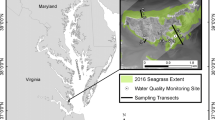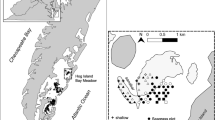Abstract
Seagrass populations have been declining globally, with changes attributed to anthropogenic stresses and, more recently, negative effects of global climate change. We examined the distribution of Zostera marina (eelgrass) dominated beds in the York River, Chesapeake Bay, VA over an 8-year time period. Using a temperature-dependent light model, declines in upriver areas were associated with higher light attenuation, resulting in lower light availability relative to compensating light requirements of Z. marina compared with downriver areas. An inverse relationship was observed between SAV growth and temperature with a change between net bed cover increases and decreases for the period of 2004–2011 observed at approximately 23 °C. Z. marina-dominated beds in the lower river have been recovering from a die-off event in 2005 and experienced another near complete decline in 2010, losing an average of 97 % of coverage of Z. marina from June to October. These 2010 declines were attributed to an early summer heat event in which daily mean water temperatures increased from 25 to 30 °C over a 2-week time period, considerably higher than previous years when complete die-offs were not observed. Z. marina recovery from this event was minimal, while Ruppia maritima (widgeongrass) expanded its abundance. Water temperatures are projected to continue to increase in the Chesapeake Bay and elsewhere. These results suggest that short-term exposures to rapidly increasing temperatures by 4–5 °C above normal during summer months can result in widespread diebacks that may lead to Z. marina extirpation from historically vegetated areas, with the potential replacement by other species.








Similar content being viewed by others
References
Abe, M., A. Kurashima, and M. Maegawa. 2008. Temperature requirements for seed germination and seedling growth of Zostera marina from central Japan. Fisheries Science 74: 589–593.
Bergmann, N., G. Winters, G. Rauch, C. Eizaguirre, J. Gu, P. Nelle, B. Fricke, B. Thorsten, and H. Reusch. 2010. Population-specificity of heat stress gene induction in northern and southern eelgrass Zostera marina populations under simulated global warming. Molecular Ecology 19: 2870–2883.
Boström, C., E. Bonsdorff, P. Kangass, and A. Norkko. 2002. Long-term changes of a brackish water eelgrass (Zostera marina L.) community indicate effects of coastal eutrophication. Estuarine. Estuarine, Coastal and Shelf Science 55: 795–804.
Burke, M.K., W.C. Dennison, and K.A. Moore. 1996. Non-structural carbohydrate reserves of eelgrass Zostera marina. Marine Ecology Progress Series 137: 195–201.
Dennison, W.C., R.C. Orth, K.A. Moore, J.C. Stevenson, V. Carter, S. Kollar, P.W. Bergstrom, and R.A. Batiuk. 1993. Assessing water quality with submersed aquatic vegetation: habitat requirements as barometers of Chesapeake Bay health. BioScience 43: 86–94.
Evans, A.S., K.L. Webb, and P.A. Penhale. 1986. Photosynthetic temperature acclimation in two coexisting seagrasses, Zostera marina L. and Ruppia maritima L. Aquatic Botany 24: 185–197.
Green, E.P., and F.T. Short. 2003. World atlas of seagrasses. Berkeley: University of California Press.
Greve, T.M., J. Borum, and O. Pedersen. 2003. Meristematic oxygen variability in eelgrass (Zostera marina L.). Limnology and Oceanography 48: 210–216.
Homer, M., and E.J. Bondgaard. 2001. Photosynthetic and growth response of eelgrass to low oxygen and high sulfide concentrations during hypoxic events. Aquatic Botany 70: 29–38.
Hughes, J.E., L.A. Deegan, J.C. Wyda, M.J. Weaver, and A. Wright. 2002. The effects of eelgrass habitat loss on estuarine fish communities of southern New England. Estuaries 25(2): 235–249.
Jarvis, J.C., and K.A. Moore. 2010. The role of seedlings and seed bank viability in the recovery of Chesapeake Bay, USA, Zostera marina populations following a large-scale decline. Hydrobiologia 649: 55–68.
Johnson, M.R., S.L. Williams, C.H. Lieberman, and A. Solbak. 2003. Changes in the abundance of the seagrasses Zostera marina L. (eelgrass) and Ruppia maritima L. (widgeongrass) in San Diego, California, following an El Niño event. Estuaries 26(1): 106–115.
Koch, E.W. 2001. Beyond light: physical, geological, and geochemical parameters as possible submersed aquatic vegetation habitat requirements. Estuaries and Coasts 24: 1–17.
Koch, E.W., and R.J. Orth. 2003. Seagrasses of the mid-Atlantic coast of the United States. In World atlas of seagrasses, ed. E.P. Green and F.T. Short, 216–223. Berkeley: University of California Press.
Lazar, A.C., and C.J. Dawes. 1991. A seasonal study of the seagrass Ruppia maritima L. in Tampa Bay, Florida. Organic constituents and tolerances to salinity and temperature. Botanica Marina 34(3): 265–269.
Marsh, G.A. 1973. The Zostera epifaunal community in the York River, Virginia. Virginia Institute of Marine Science Contribution no. 520. Gloucester Point, VA.
Marsh, G.A. 1976. Ecology of the gastropod epifauna of eelgrass in a Virginia estuary. Virginia Institute of Marine Science Contribution no. 703. Gloucester Point, VA.
Marsh Jr., J.A., W.C. Dennison, and R.S. Alberte. 1986. Effects of temperature on photosynthesis and respiration in eelgrass (Zostera marina L.). Journal of Experimental Marine Biology and Ecology 101: 257–267.
Micheli, R., M.J. Bishop, C.H. Peterson, and J. Rivera. 2008. Alteration of seagrass species composition and function over two decades. Ecological Monographs 78(2): 225–244.
Moore, K.A. 2004. Influence of seagrasses on water quality in shallow regions of the lower Chesapeake Bay. Journal of Coastal Research Special Issue No. 45: 162–178.
Moore, K.A. 2009. NERRS SWMP bio-monitoring protocol: long-term monitoring of estuarine submersed and emergent vegetation communities. National Estuarine Research Reserve System Technical Report. Silver Spring: NOAA–NERRS.
Moore, K.A., and J.C. Jarvis. 2008. Environmental factors affecting recent summertime eelgrass diebacks in the lower Chesapeake Bay: implications for long-term persistence. Journal of Coastal Research Special Issue No. 55: 135–147.
Moore, K.A., and F.T. Short. 2006. Zostera: biology, ecology, and management. In Seagrass: biology, ecology and conservation, ed. A.W.D. Larkum, R.J. Orth, and C.M. Duarte, 361–386. Amsterdam: Springer.
Moore, K.A., H.A. Neckles, and R.J. Orth. 1996. Zostera marina (eelgrass) growth and survival along a gradient of nutrients and turbidity in the lower Chesapeake Bay. Marine Ecology Progress Series 142: 247–259.
Moore, K.A., R.L. Wetzel, and R.J. Orth. 1997. Seasonal pulses of turbidity and their relations to eelgrass (Zostera marina L.) survival in an estuary. Journal of Experimental Marine Biology and Ecology 215: 115–134.
Moore, K.A., D.L. Wilcox, and R.J. Orth. 2000. Analysis of abundance of submersed aquatic vegetation communities in the Chesapeake Bay. Estuaries 23: 115–127.
Moore, K.A., E.C. Shields, D.B. Parrish, and R.J. Orth. 2012. Eelgrass survival in two contrasting systems: role of turbidity and summer water temperatures. Marine Ecology Progress Series 448: 247–258.
Najjar, R.G., H.A. Walker, P.J. Anderson, E.J. Barron, R.J. Bord, J.R. Gibson, V.S. Kennedy, C.G. Knight, J.P. Megonigal, R.E. O’Connor, C.D. Polsky, N.P. Psuty, B.A. Richards, L.G. Sorenson, E.M. Steele, and R.S. Swanson. 2000. The potential impacts of climate change on the mid-Atlantic coastal region. Climate Research 14: 219–233.
National Estuarine Research Reserve System. 2012. System-Wide Monitoring Program. http://www.nerrs.noaa.gov/RCDefault.aspx?ID=18. Accessed December 12, 2012.
Neff, R., H. Chang, C.G. Knight, R.G. Najjar, B. Yarnal, and H.A. Walker. 2000. Impact of climate variation and change on mid-Atlantic region hydrology and water resources. Climate Research 14: 207–218.
Nejrup, L.B., and M.F. Pedersen. 2008. Effects of salinity and water temperature on the ecological performance of Zostera marina. Aquatic Botany 88: 239–246.
Orth, R.J., and K.A. Moore. 1983. An unprecedented decline in submerged aquatic vegetation (Chesapeake Bay). Science 22: 51–53.
Orth, R.J., and K.A. Moore. 1984. Distribution of abundance of submerged aquatic vegetation in Chesapeake Bay: an historical perspective. Estuaries 7: 531–540.
Orth, R.J., and K.A. Moore. 1986. Seasonal and year-to-year variations in the growth of Z. marina L. (eelgrass) in the Chesapeake Bay. Aquatic Botany 24: 335–341.
Orth, R.J., and K.A. Moore. 1988. Distribution of Zostera marina L. and Ruppia maritima L. sensu lato along depth gradients in the lower Chesapeake Bay, U.S.A. Aquatic Botany 32: 291–305.
Orth, R.J., T.J.B. Carruthers, W.C. Dennison, C.M. Duarte, J.W. Fourqurean, K.L. Heck Jr., A.R. Hughes, G.A. Kendrick, W.J. Kenworthy, S. Olyarnik, F.T. Short, M. Waycott, and S.L. Williams. 2006. A global crisis for seagrass ecosystems. BioScience 56: 987–996.
Orth, R.J., S.R. Marion, K.A. Moore, and D.J. Wilcox. 2010. Eelgrass (Zostera marina L.) in the Chesapeake Bay region of Mid-Atlantic coast of the USA: challenges in conservation and restoration. Estuaries and Coasts 33: 139–150.
Orth, R.J., D.J. Wilcox, J.R. Whiting, L. Nagey, A.L. Owens, and A.K. Kenne. 2011. 2010 distribution of submerged aquatic vegetation in Chesapeake Bay and coastal bays. VIMS special scientific report # 153. Final report to US EPA Chesapeake Bay Program, Annapolis, MD.
Palacios, S.L., and R.C. Zommerman. 2007. Response of eelgrass (Zostera marina) to CO2 enrichment: possible impacts of climate change and potential for remediation of coastal habitats. Marine Ecology Progress Series 344: 1–13.
Plus, M., J.-M. Deslous-Paoli, and F. Dagault. 2003. Seagrass (Zostera marina L.) bed recolonisation after anoxia-induced full mortality. Aquatic Botany 77: 121–134.
Polsky, C., J. Allard, N. Currit, R. Crane, and B. Yarnal. 2000. The mid-Atlantic region and its climate: past present and future. Climate Research 14: 161–173.
Preston, B.L. 2004. Observed winter warming of the Chesapeake Bay estuary (1949–2002): implications for ecosystem management. Environmental Management 34: 125–139.
R Core Team (2012). R: A language and environment for statistical computing. Vienna: R Foundation for Statistical Computing.
Raum, A.L., and J. Borum. 2013. Combined impact of water column oxygen and temperature on internal oxygen status and growth of Zostera marina seedlings and adult plants. Journal of Experimental Marine Biology and Ecology 441: 16–22.
Reed, B.J., and K.A. Hovel. 2006. Seagrass habitat disturbance: how loss and fragmentation of eelgrass Zostera marina influences epifaunal abundance and diversity. Marine Ecology Progress Series 326: 133–143.
Reusch, T.B.H., A. Ehlers, A. Hämmerli, and B. Worm. 2005. Ecosystem recovery after climatic extremes enhanced by genotypic diversity. PNAS 102(8): 2826–2831.
Short, F., T. Carruthers, W. Dennison, and M. Waycott. 2007. Global seagrass distribution and diversity: a bioregional model. Journal of Experimental Marine Biology and Ecology 350: 3–20.
Siegel, S., and N.J. Castellan. 1988. Nonparametric statistics for the behavioral sciences, 2nd ed. New York: McGraw-Hill.
Staehr, P.A., and J. Borum. 2011. Seasonal acclimation in metabolism reduces light requirements of eelgrass (Zostera marina). Journal of Experimental Marine Biology and Ecology 407(2): 139–146.
Virginia Estuarine and Coastal Observing System. 2012. www.vecos.org. Accessed 11 November 2012.
Waycott, M., C.M. Duarte, T.J.B. Carruthers, R.J. Orth, W.C. Dennison, S. Olyarnik, A. Calladine, J.W. Fourqurean, K.L. Heck Jr., A.R. Hughes, G.A. Kendrick, W.J. Kenworthy, F.T. Short, and S.L. Williams. 2009. Accelerating loss of seagrasses across the globe threatens coastal ecosystems. Proceedings of the National Academy of Sciences 106: 12377–12381.
Wetzel, R.L., and P.A. Penhale. 1983. Production ecology of seagrass communities in the lower Chesapeake Bay. Marine Technology Society Journal 17: 22–31.
Winters, G., P. Nelle, B. Fricke, G. Rauch, and T.B.H. Reusch. 2011. Effects of a simulated heat wave on photophysiology and gene expression of high- and low-latitude populations of Zostera marina. Marine Ecology Progress Series 435: 83–95.
Zimmerman, R.C., R.D. Smith, and R.S. Alberte. 1989. Thermal acclimation and whole plant carbon balance in Zostera marina L. (eelgrass). Journal of Experimental Marine Biology and Ecology 130: 93–109.
Zimmerman, R.C., D.G. Kohrs, D.L. Steller, and R.S. Alberte. 1997. Impacts of CO2-enrichment on productivity and light requirements of eelgrass. Plant Physiology 115: 599–607.
Acknowledgments
We gratefully acknowledge field and laboratory assistance by B. Neikirk, J. Goins, S. Snyder, V. Hogge, A. Miller, R. Wright, B. Haywood, D. Tulipani, A. Knowles, and J. Austin. Sincere thanks to J. Jarvis and R. Orth for in-depth discussions and review of the manuscript. Funds for this project were provided by the Estuarine Research Reserve Division of the National Oceanic and Atmospheric Administration and the Commonwealth of Virginia. This is contribution no. 3300 from the Virginia Institute of Marine Science, School of Marine Science, College of William and Mary.
Author information
Authors and Affiliations
Corresponding author
Rights and permissions
About this article
Cite this article
Moore, K.A., Shields, E.C. & Parrish, D.B. Impacts of Varying Estuarine Temperature and Light Conditions on Zostera marina (Eelgrass) and its Interactions With Ruppia maritima (Widgeongrass). Estuaries and Coasts 37 (Suppl 1), 20–30 (2014). https://doi.org/10.1007/s12237-013-9667-3
Received:
Revised:
Accepted:
Published:
Issue Date:
DOI: https://doi.org/10.1007/s12237-013-9667-3




